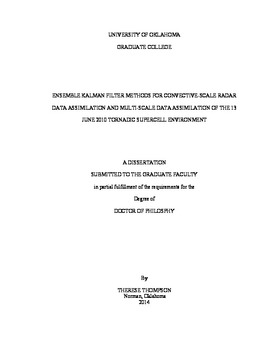| dc.contributor.advisor | Wang, Xuguang | |
| dc.contributor.advisor | Wicker, Louis | |
| dc.contributor.author | Thompson, Therese | |
| dc.date.accessioned | 2014-08-15T16:06:14Z | |
| dc.date.available | 2014-08-15T16:06:14Z | |
| dc.date.issued | 2014-08-15 | |
| dc.identifier.uri | https://hdl.handle.net/11244/10501 | |
| dc.description.abstract | Ensemble data assimilation at convective-scales will need to solve a number of scientific and technical issues prior to being usable for operational numerical weather prediction. This research contributes to this goal by first comparing the Local Ensemble Transform Kalman Filter (LETKF) to the Ensemble Square Root Filter (EnSRF) to examine whether either method consistently produces more accurate analyses and forecasts. Second, multi-scale data assimilation strategies are explored to improve the analysis of complex environmental conditions and subsequent convective forecasts.
While theoretically the LETKF and EnSRF filters should behave the same for ideal systems, a comparison between the serial and simultaneous filters has not previously been explored at the convective-scale where significant non-linear effects are present. Observing System Simulation Experiments (OSSEs) are first used to compare the assimilation systems for the analysis and forecast of a supercell thunderstorm. Both the EnSRF and LETKF produce reasonable analyses from the Doppler velocity and reflectivity observations of the true supercell. Small improvements in analysis errors and system noise from the LETKF simultaneous update do not significantly impact the subsequent forecasts. This result is consistent across a range of localization length scales and is independent of the manner in which localization is applied. Tests comparing the EnSRF and LETKF for a real-data case also have small differences. The magnitudes of these differences are similar to those that arise from the sampling variability associated with a finite ensemble. Overall, the results suggest the EnSRF and LETKF approaches are equally capable methods for radar data assimilation at convective-scales.
A multi-scale data assimilation framework is developed for an ensemble assimilation and prediction system using the Weather Research and Forecasting (WRF) model and the Data Assimilation Research Testbed (DART). A CONUS mesoscale model domain, with 15 km horizontal grid spacing, provides the boundary conditions for a nested convective-allowing model grid (3 km horizontal grid spacing). The WRF grids and the DART data assimilation toolkit are used to create analyses and forecasts of the convective environment and a tornadic storm on 13 June 2010. This case was chosen because it represents a complex mesoscale environment and storm evolution that was not captured well with conventional observations or WSR-88D radars. Thus, this case presents a challenging event to analyze and predict, and demonstrates the benefits of multi-scale data assimilation for generating initial conditions for convective-scale ensemble forecasts. Several aspects of multi-scale DA cycling are investigated through comparisons of ensemble forecast performance relative to a control 6-hourly cycled analysis system. Results indicate that increased cycling frequency improves forecasts of the mesoscale storm environment and convection. The addition of radar observations in hourly DA cycling leads to further improvement in forecast skill, which is tied to better forecasts of the outflow boundary from overnight convection and subsequent convective evolution. Lastly, the initial conditions for the multi-scale data assimilation cycling system are found to have an impact on the characteristics of the near-storm environment. | en_US |
| dc.language | en_US | en_US |
| dc.subject | Atmospheric Sciences. | en_US |
| dc.title | ENSEMBLE KALMAN FILTER METHODS FOR CONVECTIVE-SCALE RADAR DATA ASSIMILATION AND MULTI-SCALE DATA ASSIMILATION OF THE 13 JUNE 2010 TORNADIC SUPERCELL ENVIRONMENT | en_US |
| dc.contributor.committeeMember | Biggerstaff, Micheal | |
| dc.contributor.committeeMember | Shapiro, Alan | |
| dc.contributor.committeeMember | Stensrud, David | |
| dc.contributor.committeeMember | Lakshmivarahan, S. | |
| dc.date.manuscript | 2014-08-14 | |
| dc.thesis.degree | Ph.D. | en_US |
| ou.group | College of Atmospheric & Geographic Sciences::School of Meteorology | en_US |
